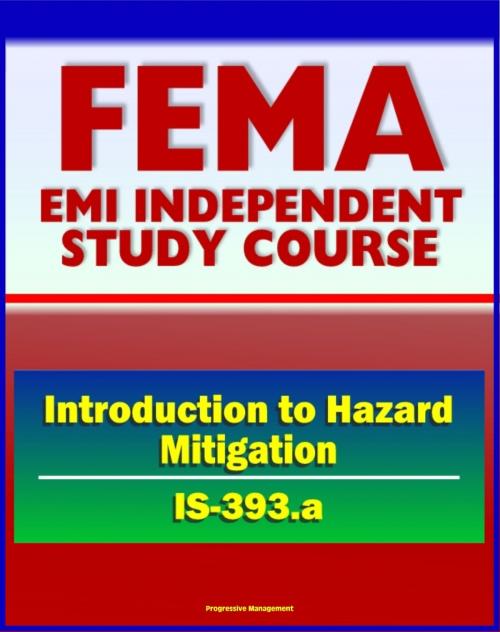21st Century FEMA Study Course: Introduction to Hazard Mitigation (IS-393.a) - Flood, Earthquake, Tornado, Hurricane, Wildfire, Critical Facilities Protection, Community Programs
Nonfiction, Social & Cultural Studies, Political Science| Author: | Progressive Management | ISBN: | 9781466197589 |
| Publisher: | Progressive Management | Publication: | July 7, 2011 |
| Imprint: | Smashwords Edition | Language: | English |
| Author: | Progressive Management |
| ISBN: | 9781466197589 |
| Publisher: | Progressive Management |
| Publication: | July 7, 2011 |
| Imprint: | Smashwords Edition |
| Language: | English |
This Federal Emergency Management Agency (FEMA) independent training course manual from the Emergency Management Institute (EMI) provides an introduction for those who are new to emergency management and/or hazard mitigation.
As the costs of disasters continue to rise, governments and ordinary citizens must find ways to reduce hazard risks to our communities and ourselves. Efforts made to reduce hazard risks are easily made compatible with other community goals; safer communities are more attractive to employers as well as residents. As communities plan for new development and improvements to existing infrastructure, mitigation can and should be an important component of the planning effort. Mitigation means taking action to reduce or eliminate long-term risk from hazards and their effects.
Lesson 1. Hazard Mitigation: Sustainable Futures for At-Risk Communities
– Explores the reasons and need for planning for a sustainable, disaster-resistant community; describes how hazard mitigation fits into the cycle of emergency management, describes hazard mitigation concepts and practices; explains the relationships between hazard mitigation planning, reducing hazard risk, and sustainable communities; and outlines several Federal initiatives to support hazard mitigation as well as the planning guidance established by the Disaster Mitigation Act of 2000.
Lesson 2. Gaining Support for Hazard Mitigation – Emphasizes the need for a systematic approach to reducing the risk of future disaster damages through mitigation planning; and introduces a systematic planning process, methods for developing community-wide support for mitigating hazard risks, and how to take the first key steps toward a local hazard mitigation program.
Lesson 3. Assessing Risks – Describes and demonstrates a methodology to determine what hazard risks potentially threaten a community and how vulnerable the community is to those risks; and explains how a community uses this risk assessment as the basis for developing hazard mitigation and emergency plans.
Lesson 4. Building and Implementing a Community Hazard Mitigation Plan
– Explains how to develop a community hazard mitigation plan; connects the risk assessment to the development of a mitigation strategy; and provides the guidelines for writing and implementing a hazard mitigation plan that meets the needs of the community as well as the plan requirements of the Disaster Mitigation Act of 2000.
Lesson 5. After a Disaster: Recovery and Hazard Mitigation Programs –Describes the role of the Federal, State, and local governments in disaster recovery, and how to identify and utilize post-disaster opportunities to implement planned hazard mitigation actions.
Each of the five lessons follows a similar format. A summary concludes the end of the descriptive portion of each lesson. Following the summary, each lesson includes an activity called Hazard Mitigation in Your Community. These activities consist of questions regarding hazards, disasters, and mitigation in your own community. Answering these questions will help you relate the course material to your own circumstances to make it more meaningful.
This is a privately authored news service and educational publication of Progressive Management.
This Federal Emergency Management Agency (FEMA) independent training course manual from the Emergency Management Institute (EMI) provides an introduction for those who are new to emergency management and/or hazard mitigation.
As the costs of disasters continue to rise, governments and ordinary citizens must find ways to reduce hazard risks to our communities and ourselves. Efforts made to reduce hazard risks are easily made compatible with other community goals; safer communities are more attractive to employers as well as residents. As communities plan for new development and improvements to existing infrastructure, mitigation can and should be an important component of the planning effort. Mitigation means taking action to reduce or eliminate long-term risk from hazards and their effects.
Lesson 1. Hazard Mitigation: Sustainable Futures for At-Risk Communities
– Explores the reasons and need for planning for a sustainable, disaster-resistant community; describes how hazard mitigation fits into the cycle of emergency management, describes hazard mitigation concepts and practices; explains the relationships between hazard mitigation planning, reducing hazard risk, and sustainable communities; and outlines several Federal initiatives to support hazard mitigation as well as the planning guidance established by the Disaster Mitigation Act of 2000.
Lesson 2. Gaining Support for Hazard Mitigation – Emphasizes the need for a systematic approach to reducing the risk of future disaster damages through mitigation planning; and introduces a systematic planning process, methods for developing community-wide support for mitigating hazard risks, and how to take the first key steps toward a local hazard mitigation program.
Lesson 3. Assessing Risks – Describes and demonstrates a methodology to determine what hazard risks potentially threaten a community and how vulnerable the community is to those risks; and explains how a community uses this risk assessment as the basis for developing hazard mitigation and emergency plans.
Lesson 4. Building and Implementing a Community Hazard Mitigation Plan
– Explains how to develop a community hazard mitigation plan; connects the risk assessment to the development of a mitigation strategy; and provides the guidelines for writing and implementing a hazard mitigation plan that meets the needs of the community as well as the plan requirements of the Disaster Mitigation Act of 2000.
Lesson 5. After a Disaster: Recovery and Hazard Mitigation Programs –Describes the role of the Federal, State, and local governments in disaster recovery, and how to identify and utilize post-disaster opportunities to implement planned hazard mitigation actions.
Each of the five lessons follows a similar format. A summary concludes the end of the descriptive portion of each lesson. Following the summary, each lesson includes an activity called Hazard Mitigation in Your Community. These activities consist of questions regarding hazards, disasters, and mitigation in your own community. Answering these questions will help you relate the course material to your own circumstances to make it more meaningful.
This is a privately authored news service and educational publication of Progressive Management.















